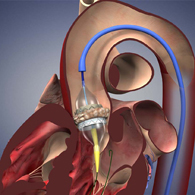Performing Valve Surgery without the Open Heart Surgery

from within the aorta, via catheter.
Aortic stenosis (narrowing of the aortic valve opening) is now the most frequently diagnosed heart valve disease. It is a potentially life-threatening condition, with a long latency period followed by rapid progression after the appearance of symptoms.
Left untreated, 50% of patients with aortic stenosis die within two years of having symptoms.
Surgical replacement of the aortic valve reduces symptoms and improves survival in patients with this illness, and in the absence of serious co-existing medical issues, the procedure is associated with very good outcomes. However, 30% of patients with severe aortic stenosis can't undergo the conventional valve replacement surgery, because of their advanced age and/or the presence of multiple other illnesses.
For these high-risk patients, a less invasive treatment has been sought and, finally, the technology to achieve it has been developed.
TAVR offers new hope for high-risk patients with severe symptomatic aortic stenosis in need of valve replacement surgery.
The new technology, approved by the FDA in the fall of 2011, is called the Edwards SAPIEN aortic valve replacement device. It is the first FDA-approved artificial aortic heart valve that's implanted without conventional "open heart" surgery.
Stony Brook University Hospital is now one of a select number of sites in the United States to offer the new minimally invasive procedure called transcatheter aortic valve replacement (TAVR) that uses the Edwards SAPIEN transcatheter heart valve.
This innovative procedure delivers a replacement valve via catheter while the heart is still beating (see illustrated description of procedure).
Clinical trial data is promising: The two-year, all-cause mortality rate is 43% compared with 68% for patients treated medically. Recovery time averages from one to two weeks. Patient selection and follow-up care involve a collaborative effort between referring physicians and our valve specialists.
Stony Brook's TAVR program is leading the way in the new era in heart surgery, where valve surgery can be performed without the surgery.
The multidisciplinary TAVR team of physicians includes two heart surgeons who are members of our faculty, Sandeep Gupta, MD, assistant professor of surgery, and Todd K. Rosengart, MD, professor and chairman of surgery, plus four cardiologists, Smadar Kort, MD, Luis Gruberg, MD, Allen Jeremias, MD, and Kathleen Stergiopoulos, MD, PhD — all with special expertise in valve disease and treating aortic stenosis.

Dr. Gupta, co-director of the Stony Brook Valve Center, explains: "TAVR provides hope for previously inoperable patients with severe aortic stenosis. This procedure uses a catheter (thin flexible tube) similar to that used in a coronary stent or angioplasty procedure. It requires no open heart incision. And so, it translates to much less discomfort than conventional surgery and, in most cases, a faster recovery."
The TAVR program is patient-focused in every aspect, from patient selection to procedure planning to treatment and postoperative care.
Indeed, the care provided at the Valve Center is distinguished by the team approach, together with easy access to Stony Brook valve specialists and excellent communication with referring physicians. In most cases, patients are seen at the Valve Center within one week of referral.
If you are a patient with severe aortic stenosis, or if you are a physician caring for a patient with this condition who could benefit from further evaluation, please call 631-638-2101 to make an appointment, or to obtain more information about our TAVR program.

